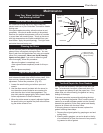
22
Dutchwest
7001219
3. Apply a thin bead of stove cement in the newly-
cleaned groove.
4. Lay the gasket into the groove. Wait until you are a
couple inches from the end before you cut it.
5. Test the gasket by closing the door on a slip of paper
as described above. Adjust the gasket in any areas
where an inadequate seal is evident.
All rope-type gasketing used in the Dutchwest Con-
vection Heater is made of fiberglass. The gasketing is
7/16” diameter for front and side doors and the ash
door and 3/8” for the top plate. 1/4” gasketing is used
behind the glass.
Repair Missing Cement in Seams
The cement in the stove seams may deteriorate over
time and fall out in places. Just as with the stove doors,
it is necessary to keep the seam seals in good condi-
tion. Spot-fix with furnace cement (available from your
local dealer) any areas where the cement seal is visibly
deteriorated. Allow 24 hours for the new cement to dry
after “washing down” seams.
Avoid Damaging the Glass Door Panel
Do not abuse the glass by slamming the door or striking
the glass with a log. Never operate your stove if it has
damaged or broken glass. If you need to replace the
glass, use only replacement glass provided by your lo-
cal Dutchwest dealer.
Damper Adjustment
With time, you may need to adjust the damper link-
age to ensure that the damper plate seals tightly when
closed. Test the damper when the stove is cold. When
turned into the closed position, the damper should be
feel “snug” but not too tight. It will become a little tighter
as the stove heats up. Use a 7/16” socket wrench with
socket extension to adjust the linkage:
1. In an alternating pattern, first loosen and then re-
move the four bolts that secure the top plate to the
sides of the stove.
2. Open the damper.
3. Loosen the adjusting bolt’s lock nut. (Fig. 28)
4. Loosen the anchor bolt’s lock nut, located on the
underside of the damper.
5. Loosen the anchor bolt a turn or two.
6. Tighten the adjusting bolt.
7. Test the damper. Make further adjustments if neces-
sary.
8. When final adjustment has been made, tighten the
adjusting bolt lock nut, the anchor bolt, and the an-
chor bolt lock nut.
Primary Air Control Adjustment
A simple spring-loaded tab maintains tension on the
primary air control lever. The air control should be loose
enough for you to easily set its position by hand, but
also snug enough to remain in that position until you
change it.
Over time, the air control may tighten or loosen. To
adjust the tension on the control, let the stove cool to
room temperature. Open the side-loading door and look
in toward the inner side of the front panel of the stove.
(Fig. 29) Locate the lower hex head bolt (A) on the
primary air manifold, just inside the door. Remove the
bolt with an open end or box end wrench to gain access
to the adjustment screw (B) inside the manifold. Insert
a Phillips screwdriver into that hole and turn the screw
clockwise to increase tension, counterclockwise to de-
crease tension. Make adjustments in small increments
and test the operation. Replace the hex head bolt when
you are done.
Note that the mechanism may tighten slightly as the
stove heats up. Your adjustment should leave the air
control snug, but not overly tight.
ST442
air control adjustment
7/10/00 djt
A
B
Air Manifold
Air Con-
trol
ST442
Fig. 29 Primary air control adjustment.
ST441
damper rod
7/7/00 djt
Adjusting Bolt
Lock Nut
Damper Rod
Anchor Bolt
ST441
Front of
Stove
Fig. 28 Damper adjustment.


















